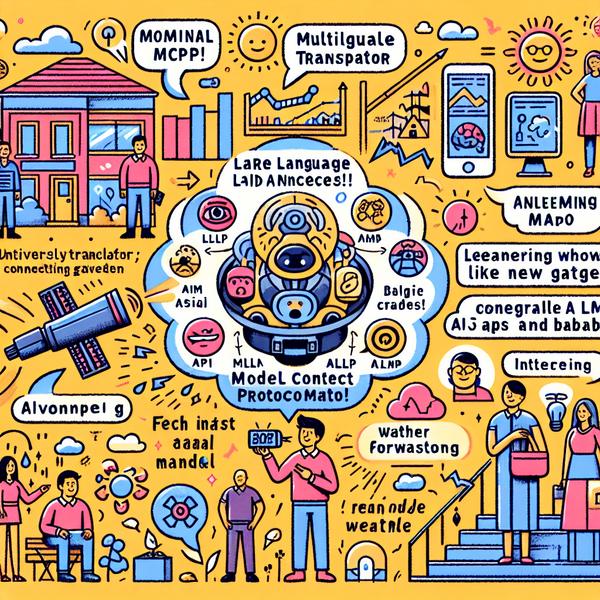
Empowering large language models (LLMs) to seamlessly interact with varied real-life environments is a groundbreaking step in AI advancements. The Model Context Protocol (MCP) enables LLMs to connect with external systems like APIs, databases, and applications without complex coding. However, mastering these connections programmatically can be tough. This challenge is met by MCP-RL, a reinforcement learning system, combined with the new ART (Agent Reinforcement Trainer) library. Together, they create agents that can learn, adapt, and self-optimize for MCP services without needing human-specific data labeling. Let’s delve deeper into this innovative setup.
Revolutionizing Large Language Models with MCP
- MCP, or Model Context Protocol, acts like a universal translator for LLMs, connecting them to tools like APIs or databases. Imagine you’re teaching a multilingual assistant to operate any new gadget just by showing it the manual—it’s that practical.
- What makes MCP amazing is its ability to sidestep traditional constraints. For instance, rather than manually programming behaviors for every task, the LLM identifies available tools by simply analyzing the MCP server endpoint.
- This is particularly useful in diverse industries. Take weather forecasting agencies—they can integrate LLMs to fetch, interpret, and report weather data automatically without crafting complicated backend APIs.
- MCP sets the stage so LLMs don’t require extensive rewiring every time they face a new server or toolset. This adaptability makes it efficient for everything from healthcare data processing to logistics management.
The Game-Changer: ART (Agent Reinforcement Trainer)
- The ART system brings a structured way of teaching LLMs through reinforcement learning. Think of ART as hiring a personalized coach for your AI model, ensuring it gets better every day without labeled datasets.
- What’s particularly exciting is ART’s flexibility—it supports a range of LLMs like Llama, Qwen, and Kimi, making it adaptable for different types of users. Whether you're a data scientist or part of a startup, ART gets you covered.
- For example, using ART in a healthcare setup can train an LLM to read medical scans, detect patterns, and provide insights without pre-existing medical data. It’s like a doctor second-opinion machine built in.
- Since no human-designed scenarios are required, ART crafts synthetic tasks to help LLMs learn intuitively—a perfect step for AI in real-world problem-solving.
Step-by-Step Guide: Automating LLM Mastery
- Here’s how MCP-RL and ART make LLM agents smarter with some simple code logic:
-
from art.rewards import ruler_score_group # MCP Server for example, such as weather reporting MCP_SERVER_URL = "https://server.smithery.ai/@smithery-ai/national-weather-service/mcp" # Step 1: Generate scenarios based on toolset scenarios = await generate_scenarios( num_scenarios=24, server_url=MCP_SERVER_URL ) # Step 2: Let the agent run and gather feedback scored_groups = [] for group in groups: judged_group = await ruler_score_group(group) scored_groups.append(judged_group) # Step 3: Train the agent for better adaptability await model.train(scored_groups) - This system works by exposing the agent to various challenges that simulate real API functionality. It’s akin to training a pilot on a simulator before they fly a real plane.
- The synthetic training, coupled with scoring via RULER (a relative evaluation engine), ensures smarter solutions without requiring labeled datasets or manual scoring—a significant cost-saver for industries.
Deep Dive: Why MCP-RL Works So Well
- MCP-RL automates tool discovery by reading OpenAPI schemas from servers. By doing so, it determines available actions and how to interact with them, like a detective decoding clues from a mysterious manual.
- A practical example: Imagine handling a ticketing API service where users need booking adjustments. MCP-RL helps the agent discover how to tap into endpoints like scheduling, canceling, or fetching booking data.
- The real magic lies in RULER scoring. Unlike static rewards, RULER compares agent attempts dynamically, ensuring better results every batch. It’s how you’d praise a student based on their improvement rather than a fixed grading scale.
- Additionally, agents excel when shifted from curated synthetic tasks to real-world ones because the training covers numerous "what-if" scenarios during the synthetic stage.
MCP-RL and ART in Everyday Applications
- So, how does all this theory translate to real problems? Let’s explore key use-cases that could benefit from this:
- Small Retailers: With MCP-RL, small e-commerce platforms can integrate APIs for inventory health, order management, and delivery systems effortlessly.
- Education: ART can assist online teaching platforms by allowing AI tutors to understand course content via APIs, helping in adaptive learning.
- Even local government systems like public transport can use these AI agents to streamline commute schedules, manage delays, and dynamically inform users about updates.
- Tested against conventional AI models, this combination outperforms earlier solutions on 67% of benchmarks, proving its lead in agent-based reinforcement learning design.